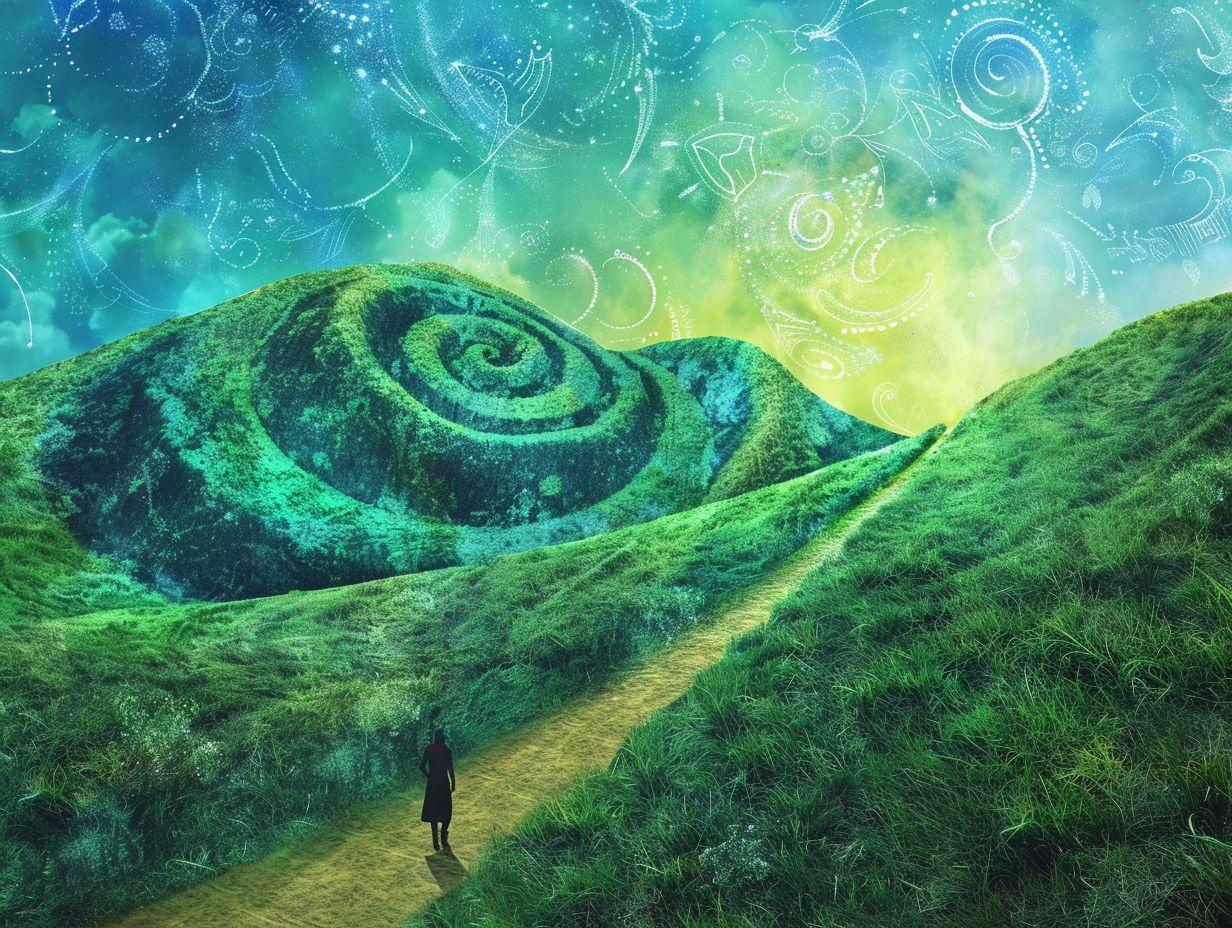The Path to Kaivalya in Samkhya Philosophy
Samkhya philosophy presents a profound examination of existence and consciousness, placing a strong emphasis on the journey toward liberation, known as Kaivalya.
This exploration delves into the fundamental principles of Samkhya and highlights the critical role that Kaivalya plays in the process of spiritual realization. It meticulously outlines the steps required to attain this elevated state, underscores the importance of discrimination (Viveka), and elucidates the transformative power of meditation.
Furthermore, it addresses common obstacles encountered along this path and offers effective strategies to overcome them, ultimately guiding individuals toward a deeper understanding and practice of these timeless teachings.
What is the Meaning of ‘Samkhya’?

Samkhya, an ancient Indian philosophical system, delves into the nature of reality through a dualistic framework that distinguishes between two fundamental entities: purusha, the eternal self, and prakriti, the material world. This philosophy emphasizes the intricate interplay between consciousness and matter, ultimately guiding individuals toward liberation from suffering and ignorance, thus paving the way for enlightenment and self-realization.
The origins of Samkhya can be traced back to the Vedic texts, where metaphysical inquiry flourished, influencing not only other schools of Indian philosophy but also a range of spiritual practices. Its significance lies in its systematic method of understanding the universe, positing that humans can attain knowledge and liberation by discerning their true nature.
Through this dualistic perspective, practitioners examine how purusha, as the witness or observer, interacts with prakriti, the elements that constitute physical existence. This understanding highlights the necessity of aligning consciousness with its true essence, thereby nurturing a profound journey toward self-awareness and truth.
What are the Main Principles of Samkhya Philosophy?
The core principles of Samkhya philosophy center on the concepts of dualism and the intrinsic distinctions between purusha and prakriti, establishing a foundation for a deeper understanding of existence and the quest for liberation. This framework underscores the significance of discernment and self-knowledge as vital instruments for transcending ignorance and attaining inner freedom.
By looking into these two fundamental aspects of reality, individuals find themselves equipped to navigate the complexities of life with heightened clarity and insight. The philosophical ramifications of this duality invite profound reflection on one s thoughts and actions, nurturing a critical awareness essential for self-realization.
As one embarks on the path of discernment, a distinction emerges between the eternal self and the ephemeral nature of the material world. This journey toward enlightenment places great emphasis on comprehending one s own mind and emotions, ultimately guiding individuals toward liberation from the cycles of suffering and delusion.
Consequently, Samkhya transcends mere theoretical discourse; it serves as a practical guide for those in pursuit of substantial inner transformation.
The Concept of Kaivalya in Samkhya Philosophy
In Samkhya philosophy, Kaivalya signifies the supreme state of liberation and transcendence, wherein the purusha fully comprehends its separation from prakriti, culminating in the experience of non-duality and the recognition of ultimate reality.
This profound state encapsulates the pinnacle of spiritual practice, allowing individuals to awaken to their true essence and achieve a profound sense of inner peace.
What is the Meaning of ‘Kaivalya’ in Samkhya Philosophy?
In Samkhya philosophy, the term ‘Kaivalya’ represents a state of absolute liberation, wherein the individual soul transcends all limitations and experiences a profound unity with cosmic consciousness. This concept embodies the very essence of spiritual growth and self-liberation, as practitioners diligently strive to attain this ultimate realization through dedicated effort and insightful contemplation.
Achieving Kaivalya requires a deep understanding of the interplay between purusha (consciousness) and prakriti (matter), guiding individuals to perceive the illusory nature of worldly attachments. To progress toward this elevated state, one may engage in practices such as meditation, self-inquiry, and yoga, all of which foster a deeper connection to one’s true essence.
Philosophically, Kaivalya signifies the dissolution of the ego and the cultivation of detachment, ultimately leading to inner peace and enlightenment. By embracing the teachings of ancient sages and integrating them into their daily lives, seekers can navigate the path of self-realization, paving the way for a harmonious existence that resonates with the universal spirit.
How is Kaivalya Different from Other Concepts of Liberation?
Kaivalya sets itself apart from other liberation concepts by emphasizing the non-dual nature of reality, where individual consciousness fully recognizes its unity with universal consciousness. This stands in stark contrast to many philosophical systems that suggest varying degrees of separation or duality in their theories of liberation. Such a unique perspective accentuates the comprehensive enlightenment that Kaivalya provides.
In contrast, numerous Eastern philosophies, particularly those rooted in Buddhism, delineate a pathway to enlightenment that revolves around detachment from the self. These traditions often advocate for a gradual unfolding of realization rather than an instantaneous acknowledgment of oneness.
Simultaneously, Western metaphysical traditions, especially those shaped by Christian theology, tend to uphold a distinct separation between the divine and the individual. They often promote salvation through grace instead of through self-realization.
This divergence in viewpoints highlights Kaivalya’s distinctive approach, proposing that liberation transcends mere escape from the cycle of rebirth or a journey toward God. Instead, it presents liberation as a profound awakening to the inherent unity that permeates all existence.
The Path to Kaivalya
The journey to Kaivalya is a complex and profound endeavor, intricately woven into the rich traditions of yoga and meditation. It demands a disciplined commitment to self-realization and spiritual growth.
This transformative path requires the practitioner to foster deep inner awareness, transcending the constraints of both mind and matter. Ultimately, this pursuit leads to liberation from suffering and the attainment of enlightenment.
What are the Steps to Achieving Kaivalya?

Achieving Kaivalya involves several essential steps that encompass a range of spiritual disciplines, including rigorous self-inquiry, meditation techniques, and the cultivation of conscious awareness, all aimed at facilitating profound inner transformation. These steps not only promote personal growth but also equip practitioners to navigate the complexities of the spiritual journey.
To embark on this transformative path, individuals must first establish a consistent meditation practice, setting aside dedicated time each day to sit in stillness and observe their thoughts without attachment. This disciplined approach not only calms the mind but also unveils deeper layers of self-awareness.
Plus meditation, self-inquiry is vital; it encourages individuals to question their beliefs and assumptions, ultimately guiding them toward the recognition of their true essence. Mindful living also plays a crucial role, fostering a heightened state of conscious awareness in daily activities.
Furthermore, the integration of breathwork and yoga can significantly enhance the harnessing of vital energy, facilitating a more profound connection to the self. Through these practices, one progressively unfolds the path toward Kaivalya, deepening their spiritual journey.
What Role do the Gunas Play in the Path to Kaivalya?
In the quest for Kaivalya, the Gunas sattva, rajas, and tamas hold a crucial significance, profoundly influencing the evolution of consciousness and the intricate relationship between purusha and prakriti. A nuanced understanding of these qualities give the power tos practitioners to skillfully navigate their spiritual journeys, cultivating the essential balance required for liberation.
By discerning how each Guna manifests within their thoughts, emotions, and actions, individuals can consciously harness these energies to facilitate their spiritual evolution. Sattva, embodying purity and wisdom, fosters clarity and harmony, inspiring practitioners to engage in practices that nurture tranquility and insight. In contrast, rajas may incite restlessness and desire, necessitating a disciplined approach to channel this dynamic energy into constructive actions. Meanwhile, tamas, which represents inertia and confusion, calls for heightened awareness and diligence to transcend its lethargic influence.
Achieving an effective balance among these Gunas is vital for deepening one’s connection with consciousness and ultimately attaining the transformative state of Kaivalya.
The Importance of Viveka in the Path to Kaivalya
Viveka, often referred to as discernment, stands as a pivotal component on the journey to Kaivalya. It give the power tos individuals to distinguish between the eternal self, or purusha, and the fleeting essence of the material world, known as prakriti.
This profound clarity not only enhances self-awareness but also serves as a guiding light for practitioners, enabling them to make insightful decisions on their spiritual quest for liberation.
What is the Role of Discrimination in Achieving Kaivalya?
The role of discrimination in achieving Kaivalya is of paramount importance, as it give the power tos practitioners to discern between the real and the unreal, ultimately guiding them along the path of liberation toward self-realization. This process of discernment is essential for overcoming ignorance and suffering, fostering profound spiritual growth.
As individuals engage deeply with their spiritual practices, they begin to cultivate an understanding that transcends superficial appearances. This refined perception not only enhances their awareness of their own thoughts and actions but also illuminates the subtle societal biases that may have impeded their journey.
By recognizing and dismantling such judgments, practitioners can experience a clearer connection to their true essence, enabling liberation from conditioned beliefs. Ultimately, this journey is about finding freedom from both internal and external obstacles, drawing practitioners closer to the realization of their innate state of Kaivalya, characterized by unity, peace, and profound insight.
How Can One Develop Viveka in their Spiritual Practice?
Developing Viveka within the realm of spiritual practice demands a dedicated approach to self-inquiry and meditation, fostering an enhanced awareness of thoughts, emotions, and the very nature of reality. Through consistent practice, individuals may cultivate discernment, paving the way for deeper insights and establishing a robust foundation for their spiritual journey.
To effectively nurture this sense of discernment, one should consider allocating dedicated time each day for reflection, creating space to observe recurring thought patterns without judgment. Engaging in mindfulness meditation can significantly amplify this process, encouraging individuals to remain present and attuned to their internal experiences.
Journaling insights gleaned from these meditative practices acts as a valuable tool for self-discovery, illuminating aspects of the self that warrant attention. Furthermore, incorporating guided meditations centered on understanding the transient nature of thoughts can assist in recognizing what truly matters along one s spiritual path, ultimately fostering transformative growth.
The Role of Meditation in Attaining Kaivalya
Meditation occupies a central position in the journey toward Kaivalya, acting as an essential instrument for spiritual awakening and self-realization. Through committed meditation practices, individuals can foster profound inner peace, enhance their connection to the eternal self, and adeptly navigate the intricate tapestry of existence.
How Does Meditation Help in the Attainment of Kaivalya?

Meditation serves as a powerful catalyst for attaining Kaivalya by enhancing self-awareness and fostering a profound understanding of consciousness and the nature of reality. This practice give the power tos individuals to transcend their mental limitations, culminating in significant spiritual growth and a clearer perception of the self.
Through dedicated meditation, a person gradually unveils the intricate layers of their mind, recognizing previously unnoticed patterns of thought and emotional responses. This heightened awareness cultivates not only personal growth but also paves the way for deep insights into the interconnectedness of all existence.
By prioritizing meditation, the individual creates a tranquil inner sanctuary where distractions dissipate and a richer connection to their true essence emerges. This transformative journey nourishes the spirit, guiding practitioners toward liberation and a state of complete unity, ultimately aligning them with the essence of Kaivalya.
What Types of Meditation are Recommended in Samkhya Philosophy?
In the realm of Samkhya philosophy, a variety of meditation practices are recommended, including mindfulness, transcendental meditation, and self-reflection, each tailored to serve distinct purposes on the path to Kaivalya. These practices encourage individuals to cultivate focused awareness and delve deep into the layers of their consciousness.
Mindfulness meditation places a strong emphasis on present-moment awareness, enabling practitioners to observe their thoughts and feelings without attachment. This non-judgmental observation enhances emotional regulation and clarity of mind.
Transcendental meditation, in contrast, centers on effortless awareness, guiding practitioners beyond ordinary thought patterns. This approach leads to profound states of rest and rejuvenation, allowing for a refreshing mental reset.
Self-reflection engages individuals in introspective practices that foster personal insights and self-understanding. This journey inward nurtures emotional healing and growth, providing a compass for navigating the complexities of life.
Collectively, these diverse meditation modalities synergistically support the journey toward ultimate liberation, fostering a profound inner calm and heightened self-awareness that are essential for spiritual advancement.
Obstacles in the Path to Kaivalya
The journey toward Kaivalya is frequently laden with obstacles, encompassing spiritual challenges that stem from ignorance and suffering. These hurdles can significantly impede progress and self-realization.
Therefore, recognizing and addressing these barriers is essential for effectively navigating the path toward liberation.
What Are Some Common Obstacles Faced in the Path to Kaivalya?
The journey toward Kaivalya is often fraught with common obstacles such as distractions, ignorance, and emotional turbulence, each capable of obstructing the pursuit of inner peace and self-realization. By identifying these barriers, practitioners can devise effective strategies to overcome them.
Distractions, in particular, can significantly derail progress, as they divert attention from the present moment, thereby hindering the cultivation of self-awareness. Meanwhile, ignorance of one s own thought patterns and behaviors can lead to missed opportunities for growth and a deeper understanding of oneself. Emotional turbulence adds another layer of complexity, creating a chaotic inner environment that complicates decision-making and self-reflection.
Confronting these challenges is imperative for anyone aspiring to achieve Kaivalya, as doing so cultivates resilience and enhances the ability to maintain focus. By recognizing and addressing these hurdles, individuals not only enrich their journey toward eternal bliss but also lay the groundwork for profound emotional stability and clarity.
How Can One Overcome These Obstacles?
Overcoming obstacles on the path to Kaivalya necessitates a proactive approach that emphasizes mindfulness, self-discipline, and consistent spiritual practice to navigate challenges with efficacy. By cultivating awareness and resilience, practitioners can transcend barriers and continue their journey toward liberation.
This journey often presents unexpected hurdles, which may appear daunting but also serve as valuable opportunities for growth. Incorporating mindfulness into daily routines enables individuals to remain present and attuned to their thoughts, thereby facilitating improved emotional regulation. Self-discipline serves as the backbone of sustained practice, guiding practitioners to maintain focus amid distractions.
Regular meditation and reflection can reinforce these practices, fostering a deeper connection to one s true self. Recognizing setbacks as natural components of the journey encourages resilience, give the power toing individuals to bounce back stronger and more determined than ever in their pursuit of the ultimate goal of Kaivalya.
Frequently Asked Questions
1. What is the concept of Kaivalya in Samkhya philosophy?

Kaivalya is the ultimate goal of Samkhya philosophy, which is the state of absolute liberation and transcendence. It is the state of complete detachment from all material and worldly attachments, leading to ultimate spiritual realization.
2. What is the path to attaining Kaivalya in Samkhya philosophy?
The path to attaining Kaivalya in Samkhya philosophy involves the practice of the threefold discipline of knowing, detaching, and realizing. This includes the cultivation of knowledge, detachment from material desires and attachments, and realization of the true nature of the self.
3. How does Samkhya philosophy view the self?
According to Samkhya philosophy, the self is pure consciousness, separate from the material world and the body. It is eternal and unchanging, and the ultimate goal is to realize this true nature of the self through the path to Kaivalya.
4. What is the role of yoga in the path to Kaivalya in Samkhya philosophy?
Yoga plays a crucial role in the path to Kaivalya in Samkhya philosophy as it helps to still the mind, control the senses, and detach from material desires. Through the practice of yoga, one can cultivate the necessary mental and physical discipline to attain Kaivalya.
5. How does Samkhya philosophy differ from other schools of Indian philosophy?
Samkhya philosophy differs from other schools of Indian philosophy in its emphasis on dualism and the concept of Purusha and Prakriti. It also focuses on the path of knowledge rather than devotional practices, as in other schools such as Yoga and Vedanta.
6. Can anyone attain Kaivalya in Samkhya philosophy?
According to Samkhya philosophy, anyone can attain Kaivalya through dedicated practice and discipline, regardless of their gender, caste, or social status. It is a universal path that can be followed by anyone seeking ultimate spiritual liberation.
